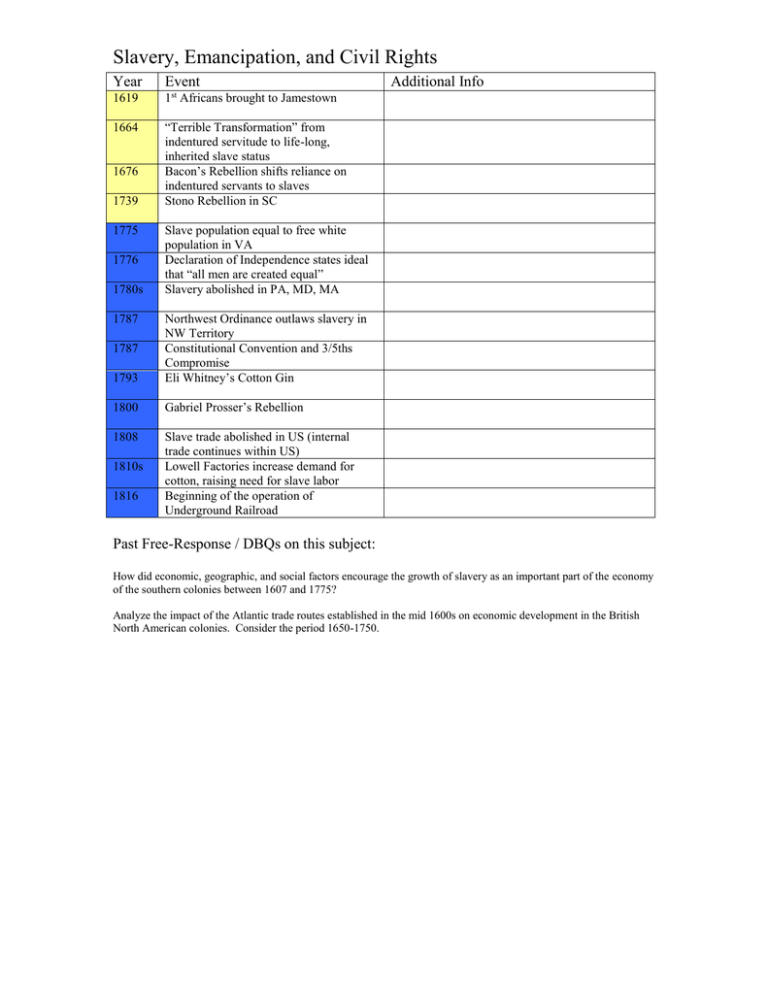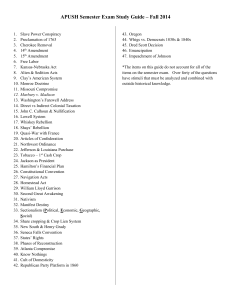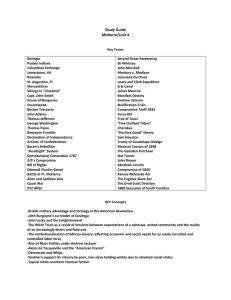Year
advertisement

Slavery, Emancipation, and Civil Rights Year Event 1619 1st Africans brought to Jamestown 1664 “Terrible Transformation” from indentured servitude to life-long, inherited slave status Bacon’s Rebellion shifts reliance on indentured servants to slaves Stono Rebellion in SC 1676 1739 1775 1776 1780s 1787 Slave population equal to free white population in VA Declaration of Independence states ideal that “all men are created equal” Slavery abolished in PA, MD, MA 1793 Northwest Ordinance outlaws slavery in NW Territory Constitutional Convention and 3/5ths Compromise Eli Whitney’s Cotton Gin 1800 Gabriel Prosser’s Rebellion 1808 Slave trade abolished in US (internal trade continues within US) Lowell Factories increase demand for cotton, raising need for slave labor Beginning of the operation of Underground Railroad 1787 1810s 1816 Additional Info Past Free-Response / DBQs on this subject: How did economic, geographic, and social factors encourage the growth of slavery as an important part of the economy of the southern colonies between 1607 and 1775? Analyze the impact of the Atlantic trade routes established in the mid 1600s on economic development in the British North American colonies. Consider the period 1650-1750. Slavery, Emancipation, and Civil Rights Year Event 1820 Missouri Compromise is “Fire bell in the Night” American Colonization Society est. Liberia Denmark Vesey Rebellion Wm. Lloyd Garrison’s “Liberator” published Nat Turner’s Rebellion Gag Rule in Congress Elijah Lovejoy killed “Narrative of Frederick Douglass” Wilmot Proviso Douglass publishes “North Star” Compromise of 1850/Fugitive Slave Law/Popular Sovereignty Uncle Tom’s Cabin Kansas-Nebraska Act/Republican Party formed Sumner incident/Bleeding Kansas Dred Scott decision Lincoln-Douglas Debates/Freeport Doctrine John Brown’s Raid on Harper’s Ferry Election of Lincoln/Secession of Confederate States/Civil War Emancipation Proclamation Sherman’s Field Order No. 15 13th Amendment passed by Congress Freedman’s Bureau Mississippi Black Codes enacted 1821 1822 1831 1831 1836 1837 1845 1846 1847 1850 1852 1854 1856 1857 1858 1859 1860-61 1863 1865 1865 1865 1865 Additional Info Past Free-Response / DBQs on this subject: Assess the moral arguments and political actions of those opposed to slavery in the context of TWO of the following: Missouri Compromise Mexican War Compromise of 1950 Kansas-Nebraska Act Analyze the effectiveness of political compromise in reducing sectional tensions in the period 1820-1861. DBQ – In the early nineteenth century, Americans sought to resolve their political disputes through compromise, yet by 1860 this no longer seemed possible. Analyze the reasons for this change. Use the documents and your knowledge of the period 1820-1860 in constructing your response. To what extent did the debates about the Mexican War and its aftermath reflect the sectional interests of New Englanders, westerners, and southerners in the period from 1845 to 1855? Slavery, Emancipation, and Civil Rights Year Event 1865 1866 13th Amendment Congress passes 14th Amendment (ratified 1868) KKK formed Radical Republicans pass Military Reconstruction Acts 15th Amendment/Hiram Revels/Enforcement Acts Amnesty Act Slaughterhouse Cases grant states wide control over individual citizens; waters down 14th Am. Civil Rights Act outlaws discrimination in public places and employment Hayes Compromise withdraws Union troops from South Exoduster migration BT Washington est. Tuskegee Supreme Court declares 1875 CR Act unconstitutional Mississippi Plan enacts poll taxes BT Washington’s “Atlanta compromise” speech Plessy v Ferguson – “Separate but Equal” Grandfather Clause DuBois’ “The Souls of Black Folk” NAACP founded D.W. Griffith’s “Birth of a Nation” Garvey & UNIA Red Summer Revival of KKK Shift of African Americans to Dems -(FDR’s New Deal Coalition) Richard Wright’s “Native Son” Fair Employment Practices Commission formed following Randolph’s March on Wash plans CORE founded To Secure These Rights endorsed by Truman Jackie Robinson Truman desegregates military Sweatt and McLaurin cases Ralph Ellison’s “Invisible Man” 1866 1867 1870 1872 1873 1875 1877 1878 1881 1882 1890 1895 1896 1898 1903 1909 1915 1916 1919 1920s 1936 1940 1941 1942 1947 1947 1948 1950 1952 Additional Info Past Free-Response / DBQs on this subject: Explain why and how the role of the federal government changed as a result of the Civil War with respect to TWO of the following during the period 1861-1877: Race relations Economic development Westward expansion How did the African American Civil Rights movement of the 1950s and 1960s address the failures of the Reconstruction Period? Slavery, Emancipation, and Civil Rights Year Event 1954 1955 1955 1955 Brown v Board of Education Southern Manifesto Emmett Till Rosa Parks and Montgomery Bus Boycott SCLC Little Rock Confrontation at Central High Lorraine Hansberry’s “A Raisin in the Sun” Sit-in Movement starts in Greensboro NC/SNCC formed Freedom Riders Univ of MS and Univ. of AL integrated by federal order Project C in Birmingham/March on Washington Civil Rights Act of 1964 & 24th Amendment outlaws poll tax Mississippi Summer Project Voting Rights March in Selma/Voting Rights Act passed Malcolm X assassinated/Watts riot SNCC shifts focus/Black Panthers formed Thurgood Marshall named to Supreme Court Loving v VA outlaws states laws barring interracial marriage Dr. King assassinated Bakke v University of Calif. Jesse Jackson runs for Dem presidential nomination 1956 1957 1959 1960 1961 1962-3 1963 1964 1964 1965 1965 1966 1967 1967 1968 1978 1980s 1992 Rodney King verdict 2008 Election of Barack Obama Additional Info Past Free-Response / DBQs on this subject: Compare and contrast United States society in the 1920s and the 1950s with respect to TWO of the following: Race relations Role of women Consumerism Analyze the extent to which TWO of the following transformed American society in the 1960s and 1970s. Civil Rights movement The antiwar movement The women’s movement Discuss, with respect to TWO of the following, the view that the 1960s represented a period of profound cultural change. Education Gender roles Music Race relations “Between 1960 and 1975, there was great progress in the struggle for political and social equality.” Assess the validity of this statement with respect to TWO of the following groups during that period. African Americans Asian Americans Latinos Native Americans Women




